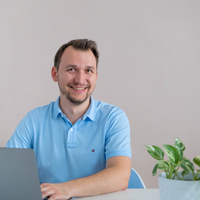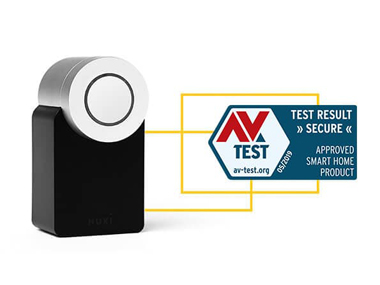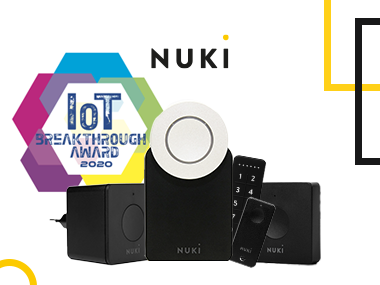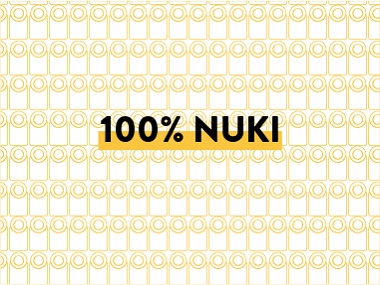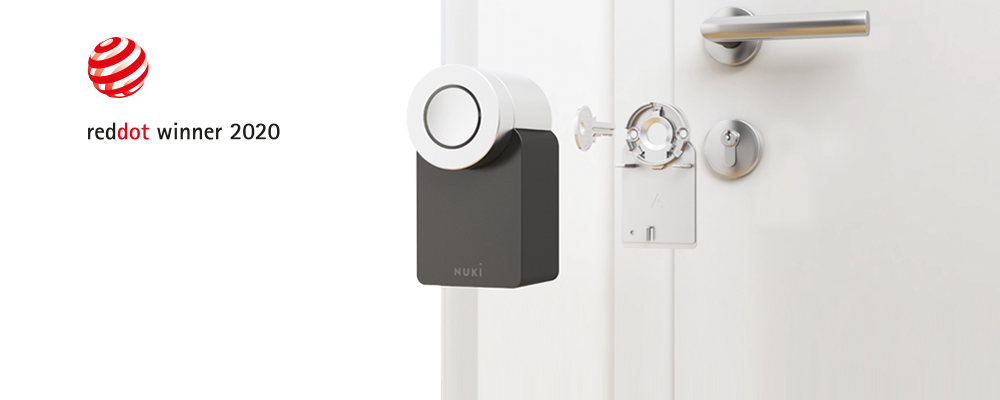
Nuki Smart Lock 2.0 wins Red Dot Design Award
Nuki NewsWe are pleased to be able to announce some more great news: The Nuki Smart Lock 2.0 has been awarded the Red Dot as part of the prestigious Red Dot Award: Product Design 2020 competition!
The “Red Dot” prize is awarded to high-quality designs. The international jury only awards this coveted seal of quality to products with outstanding designs, features and ergonomics. We are delighted that the Nuki Smart Lock 2.0, which we developed in collaboration with our design partner EOOS, is among this prestigious group of prize-winning products.
To mark the occasion, we would like to welcome those behind the design of the Nuki Smart Lock 2.0 to the stage: In the interview, Harald Gründl, Gernot Bohmann and Martin Bergmann, the creative mastermind at the Vienna design agency EOOS, and Jürgen Pansy, Head of Product at Nuki, discuss design principles, the attraction and the challenges of smart access to your own home.
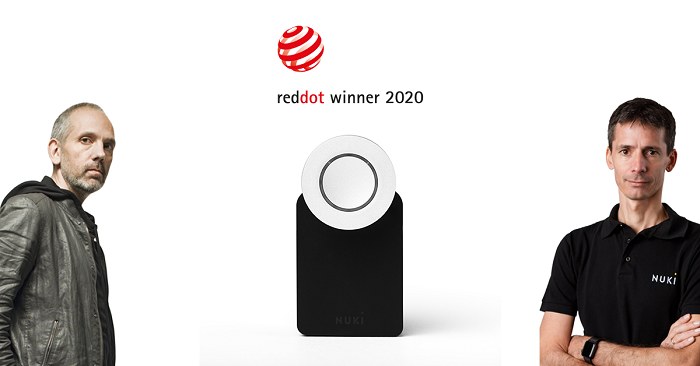
Nuki had the idea in 2013. What role did design play in product development?
Pansy: I think the key point is that the Smart Lock is used for retrofitting. It is therefore important that what you fit on the door cylinder matches the door perfectly too. It was clear to us that the design had to be consistent if the whole thing was to be a success. This resulted in the aluminium rotating knob which represents an extension of the cylinder, while the rest of the Smart Lock is kept rather simple. The use of too many different colours was avoided, and there was to be only one knob, which you can press. In this way, our own values are also reflected in the product.
The Nuki Smart Lock 2.0 enables smart access to your own home and turns your smartphone into a smart key. How did you get involved in this project?
Gründl: At EOOS, our work often involves furniture, but also product designs such as Zumtobel LED spotlights. We hadn’t produced any designs for electronic products before. For us, the Nuki project was very interesting because it was the first time we had collaborated with a start-up. Before that, we had only worked with well-established, major premium brands — from Giorgio Armani to Adidas and Lamy. The exciting thing about our collaboration was that we came from completely different directions. What sets our collaboration apart is the fact that both EOOS and Nuki strive for a perfect product. Nuki is now the leading premium door lock for the retrofit market. From hearts and minds come great products. At this stage, product design is an investment in the future — this can go well or go wrong. Ultimately, it is a really high-risk decision. For us, the most important starting point is a good basis of communication with the company; getting the feeling that we are talking to each other and sharing our thoughts and dreams. This way, we take this risk together.
Pansy: Communication with EOOS has always worked very well. It has with our manufacturer Aquis too, because digital coordination is very fast. The biggest contribution we made was actually to keep saying: We can go this far here, and this far there. And there were a lot of these decisions.
Please tell us a little about the history of the origin and development. Did everything always run smoothly and go to plan? What challenges did you face during development?
Pansy: The biggest challenge from Nuki’s point of view at that time was definitely that we knew very little about hardware development. Prior to that, we had only created software, web portals and mobile apps. So it was really exciting to collaborate with companies that were already working on hardware projects. We have always challenged each other in order to get the most out of our ideas. During the various prototype phases, it became apparent that the design we had chosen at the beginning had disadvantages that we didn’t want to settle for. The biggest challenge was definitely anticipating these obstacles as soon as possible, because as a start-up, you can’t afford to build countless prototypes. On the other hand, you cannot always just allow yourself to take the path of least resistance either. You have to be able to compromise. The combination of all these elements then results in the optimum finished product.
Gründl: When it comes to software, Nuki’s core skills are beyond doubt, especially in relation to security — which is one of our main criteria and is vital to the credibility of the project. But the Nuki Smart Lock consists of hardware too. I had great respect for these components from the very start. Nuki wouldn’t have been the first start-up to trip up when it came to hardware. Many projects fail here because they underestimate it. Another challenge was ensuring that the software, hardware and design formed a coherent whole.
How did you imagine your work to develop in technical terms? What was your guiding principle?
Gründl: The original idea was a simple knob that you press. This knob was intended to replace a mechanical key. This was actually our guiding principle, but our technical partners advised us against it. However, this principle still exists. A project in which the knob is integrated directly into doors is actually underway (see Works with Nuki). For the Nuki Smart Lock, there were security aspects that we had to consider, of course. It is well-protected from the outside, because you install it on the door interior. From the inside, however, we had to ask: What happens in the event of an emergency? It was in response to this that the distinctive rotary knob was created. We wanted the Smart Lock to be like a door knob.
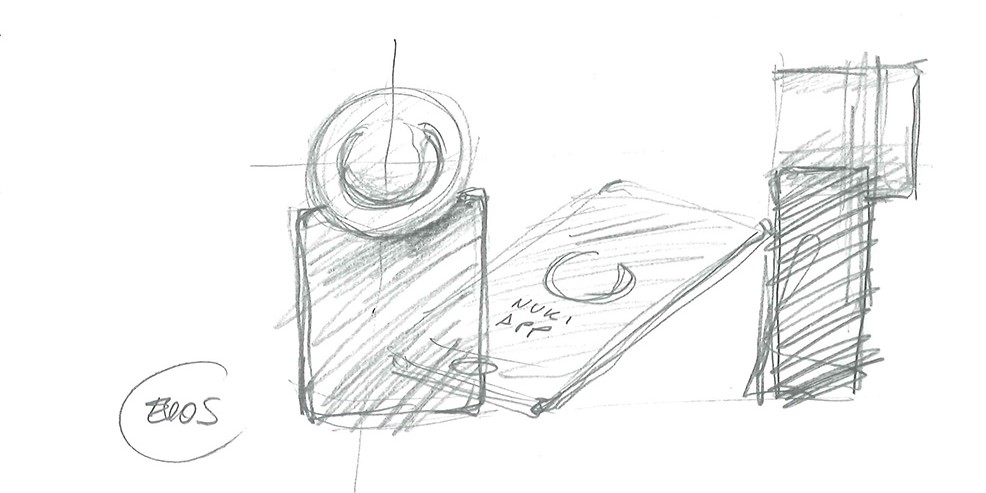
For the material for the ring, we drew inspiration from metal handles and door plates. The thinking behind this was that this part of the Smart Lock, which you touch, also has this look and feel. This is also where the circle imagery originated from. We wanted to symbolise opening and closing using a circle which is either open or closed. This distinctive symbol is used in both the hardware and the software and links the two levels.
Did you imagine that the product would look like it looks today? Were there any alternative designs?
Pansy: The very first version of the design was a rendering. This version actually looked very similar to the current design. In principle, it was a smartphone on a door with a rotary knob. In the interim, designs did become very cube-shaped. We then returned to the knob and smartphone design. Looking back, the funny thing is that the very first design and the final product are not that far apart. It’s interesting how this happened.
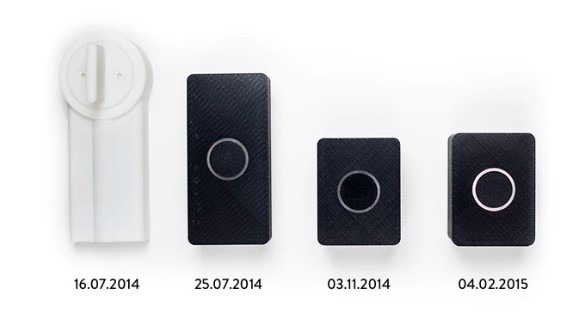
You just mentioned the circle symbol. Where else do you draw inspiration for your product designs from?
Gründl: At EOOS, our way of working is strongly influenced by pictures, rituals and stories. We call it “poetic analysis”. For us, a product design is good if it is poetic. The Smart Lock builds a bridge between these worlds. People are always torn between the analogue and the digital. And the nice thing about the Smart Lock is that it combines these two aspects.
Which things are important to you during your projects? What are your goals when developing products?
Pansy: Behind each of our products is a vision and a problem that we want to solve. In principle, we always consider how accurately we can realise this vision using existing technology. With the Nuki Smart Lock 2.0, I don’t need a conventional key, because the door recognises me and automatically lets me in. That is why we at Nuki do what we do. Maximum product benefits for customers must always be achieved; we won’t compromise on this. What’s more: The benefits of the product must not be diminished as a result of design-related decisions. We had already drawn up the benefits of the product to us before developing the design. As the process continued, we tried not to deviate from these product benefits and the previously defined use cases while still producing the perfect design.
What does good product design mean to you?
Gründl: As the product portfolio doesn’t just contain the Smart Lock anymore but now includes many other products as well, it was important to not just design one product, but to have a design concept for all future products too. With Nuki, this was successful. Whether the Nuki Bridge or the Nuki Fob — they are all “Nuki” in one way or another. After all, it was always clear that when a light is illuminated, it is bright white. In this way, you are also developing a brand identity.
Pansy: So the design of a product is good if you enjoy using the product. On the one hand, this involves the design — it has to be appealing. On the other hand, the product has to have the desired features. It’s actually quite simple: The product must be fun to use. At Nuki, we also strive for the perfect product, and try to get closer and closer to it with every iteration. At the end of the day, the only perfect product is the product that the customer wants.
Thank you for the interview!
Image rights: EOOS
